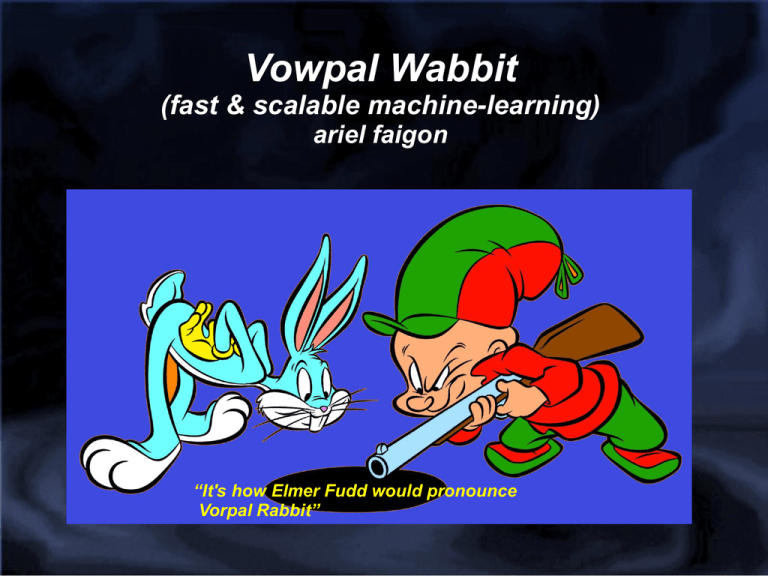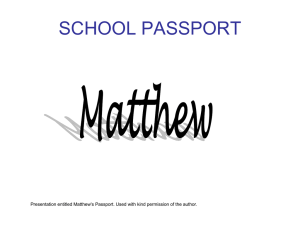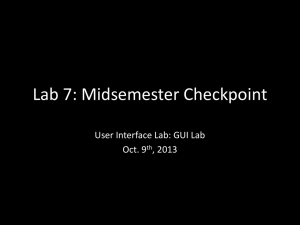Document
advertisement

Vowpal Wabbit
(fast & scalable machine-learning)
ariel faigon
“It's how Elmer Fudd would pronounce
Vorpal Rabbit”
What is Machine Learning?
In a nutshell:
- The process of a computer (self) learning from data
Two types of learning:
Supervised:
Unsupervised: no labels, e.g. clustering
learning from labeled (answered) examples
Supervised Machine Learning
y = f (x1, x2, … , xN)
y:
output/result we're interested in
X1, … , xN :
inputs we know/have
Supervised Machine Learning
y = f (x1, x2, … , xN)
Classic/traditional computer science:
We have:
x1, … , xN
We want:
y
(the input)
(the output)
We spend a lot of time and effort thinking and coding
We call
f
“the algorithm”
f
Supervised Machine Learning
y = f (x1, x2, … , xN)
In more modern / AI-ish computer science:
We have:
x1, … , xN
We have:
y
We have a lot of past data, i.e. many instances (examples)
of the relation y = f (x1, …, xN) between input and output
Supervised Machine Learning
y = f (x1, x2, … , xN)
We have a lot of past data, i.e. many instances (examples)
of the relation y = ? (x1, …, xN) between input and output
So why not let the computer find f for us ?
When to use supervised ML?
y = f ( x1, x2, … , xN )
3 necessary and sufficient conditions:
1) We have a goal/target, or question y
which we want to predict or optimize
2) We have lots of data including y 's and related X i 's:
i.e: tons of past examples y =
3) We have no obvious algorithm
f (x1, … , xN)
f linking y to (x1, …, xN)
Enter the vowpal wabbit
Fast, highly scalable, flexible, online learner
Open source and Free (BSD License)
Originally by John Langford
Yahoo! & Microsoft research
Vorpal (adj): deadly
(Created by Lewis Carroll to describe a sword)
Rabbit (noun): mammal associated with speed
vowpal wabbit
Written in C/C++
Linux, Mac OS-X, Windows
Both a library & command-line utility
Source & documentation on github + wiki
Growing community of developers & users
What can vw do?
Solve several problem types:
- Linear regression
- Classification (+ multi-class)
[using multiple reductions/strategies]
- Matrix factorization (SVD like)
- LDA (Latent Dirichlet Allocation)
- More ...
vowpal wabbit
Supported optimization strategies
(algorithm used to find the gradient/direction
towards the optimum/minimum error):
- Stochastic Gradient Descent (SGD)
- BFGS
- Conjugate Gradient
vowpal wabbit
During learning, which error are we trying to optimize (minimize)?
VW supports multiple loss (error) functions:
- squared
- quantile
- logistic
- hinge
vowpal wabbit
Core algorithm:
- Supervised machine learning
- On-line stochastic gradient descent
- With a 3-way iterative update:
--adaptive
--invariant
--normalized
Gradient Descent in a nutshell
Gradient Descent in a nutshell
from 1D (line) to 2D (plane)
find bottom (minimum) of valley:
We don't see
the whole picture,
only a local one.
Sensible direction
is along
steepest gradient
Gradient Descent: challenges & issues
Local vs global optimum
Non normalized steps
Step too big / overshoot
Gradient Descent: challenges & issues
Saddles
Unscaled & non-continuous dimensions
Much higher dimensions than 2D
What sets vw apart?
SGD on steroids:
invariant
adaptive
normalized
What sets vw apart?
SGD on steroids
Automatic optimal handling of “scales”:
No need to normalize feature ranges
Takes care of unimportant vs important features
Adaptive & separate per feature learning rates
feature = one dimension of input
What sets vw apart?
Speed and scalability:
Unlimited data-size (online learning)
~5M features/second on my desktop
Oct 2011 learning speed record:
12
10 (tera) features in 1h on 1k node cluster
What sets vw apart?
The “hash trick”:
num:6.3
color=red
age<7y
Feature names are hashed fast (murmur hash 32)
Hash result is index into weight-vector
No hash-map table is maintained internally
No attempt to deal with hash-collisions
What sets vw apart?
Very flexible input format:
Accepts sparse data-sets, missing data
Can mix numeric, categorical/boolean features in
natural-language like manner (stretching the hash trick):
size:6.3
color=turquoise
age<7y
is_cool
What sets vw apart?
Name spaces in data-sets:
Designed to allow feature-crossing
Useful in recommender systems
e.g. used in matrix factorization
Self documenting:
1 |user age:14 state=CA … |item books
price:12.5 …
0 |user age:37 state=OR … |item electronics price:59 …
Crossing users with items:
$ vw -q ui did_user_buy_item.train
What sets vw apart?
Over-fit resistant:
On-line learning: learns as it goes
–
- Compute y from x i … based on current weigths
–
- Compare with actual (example) y
–
- Compute error
–
- Update model (per feature weights)
–
Advance to next example & repeat...
Data is always “out of sample”
(exception: multiple passes)
What sets vw apart?
Over-fit resistant (cont.):
Data is always “out of sample” …
So model error estimate is realistic (test like)
Model is linear (simple) – hard to overfit
No need to train vs test or K-fold cross-validate
Biggest weakness
Learns linear (simple) models
Can be partially offset / mitigated by:
- Quadratic / cubic (-q / --cubic options)
to automatically cross features
- Early feature transform (ala GAM)
Demo...
Demo
Step 1:
Generate a random train-set:
Y = a + 2b - 5c + 7
$ random-poly -n 50000 a + 2b - 5c + 7 > r.train
Demo
Random train-set:
Y = a + 2b - 5c + 7
$ random-poly -n 50000 a + 2b - 5c + 7 > r.train
Quiz:
Assume random values for (a, b, c) are in the range [0 , 1)
What's the min and max of the expression?
What's the distribution of the expression?
getting familiar with our data-set
Random train-set:
Y = a + 2b - 5c + 7
Min and max of Y: (2, 10)
Density distribution of Y (related to, but not Irwin-Hall):
a + 2b – 5c + 7
{a, b, c} ∊ [0, 1)
Demo
Step 2:
Learn from the data & build a model:
$ vw -l 5 r.train -f r.model
Quiz: how long should it take to learn from
(50,000 x 4) (examples x features)?
Demo
Step 2:
$ vw -l 5 r.train -f r.model
Q: how long should it take to learn from
(50,000 x 4) (examples x features)?
A: about 1 /10th (0.1) of a second on
my little low-end notebook
Demo
Step 2 (training-output / convergence)
$ vw -l 5 r.train -f r.model
Demo
error convergence towards zero w/ 2 learning rates:
$ vw r.train
$ vw r.train -l 10
vw error convergence w/ 2 learning rates
vw error convergence w/ 2 learning rates
Caveat: don't overdo learning rate
It may start strong and end-up weak
(leaving default alone is a good idea)
Demo
Step 2 (looking at the trained model weights):
$ vw-varinfo -l 5 -f r.model r.train
Demo
Step 2 (looking at the trained model weights):
$ vw-varinfo -l 5 -f r.model r.train
Perfect weights for {a, b, c} & the hidden constant
Q: how good is our model?
Steps 3, 4, 5, 6:
Create independent random data-set
for same expression: Y = a + 2b - 5c + 7
Drop the Y output column (labels)
Leave only input columns (a, b, c)
Run vw: load the model + predict
Compare Y predictions
to Y actual values
test-set Ys (labels) density
predicted vs. actual (top few)
predicted
actual
Q: how good is our model?
Q.E.D
Demo – part 2
Unfortunately, real life is never so perfect
so let's repeat the whole exercise
with a distortion:
Add “global” noise to each train-set result (Y)
& make it “wrong” by up to [-1 , +1]
$ random-poly -n 50000 -p6 -r -1,1 a + 2b - 5c + 7 > r.train
NOISY train-set Ys (labels) density
random [-1 , +1] added to Ys
range falls outside [2 ,10]
due to randomly added [-1 , +1]
Original Ys vs NOISY train-set Ys (labels)
random [-1 , +1] added to Ys
OK wabbit,
lessee how
you wearn fwom this!
train-set Ys range falls outside [2 ,10]
due to randomly added [-1 ,1]
NOISY train-set – model weights
no fooling bunny
model built from global noisy data
has still near perfect weights {a, 2b, -5c, 7}
global-noise predicted vs. actual (top few)
predicted
actual
predicted vs test-set actual w/ NOISY train-set
bunny rulez!
surprisingly good
because noise is unbiased/symmetric
Demo – part 3
Let's repeat the whole exercise
with a more realistic (real-life) distortion:
Add noise to each train-set variable separately
& make it “wrong” by up to +/- 50% of its magnitude:
$ random-poly -n 50000 -p6 -R -0.5,0.5 a + 2b - 5c + 7 > r.train
all-var NOISY train-set Ys (labels) density
range falls outside [2 ,10] + skewed density
due to randomly added [+/- 50% per variable]
expected vs per-var NOISY train-set Ys (labels)
Hey bunny,
lessee you
leawn fwom this!
Nice mess: skewed, tri-modal, X shaped
due to randomly added +/- 50% per var
expected vs per-var NOISY train-set Ys (labels)
+2b
a
-5c
Hey bunny,
lessee you
leawn fwom this!
Nice mess: skewed, tri-modal, X shaped
due to randomly added +/- 50% per var
per-var NOISY train-set – model weights
model built from this noisy data
is still remarkably close to the perfect
{a, 2b, -5c, 7} weights
per-var noise predicted vs. actual (top few)
predicted
actual
predicted vs test-set actual w/ per-var NOISY train-set
Bugs p0wns Elmer again
remarkably good
because even per-var noise is unbiased/symmetric
there's so much more in vowpal wabbit
Classification
Reductions
Regularization
Many more run time options
Cluster mode / all-reduce…
The wiki on github is a great start
“Ve idach zil gmor” (Hillel the Elder)
“As for the west - go leawn” (Elmer's translation)
Questions?




